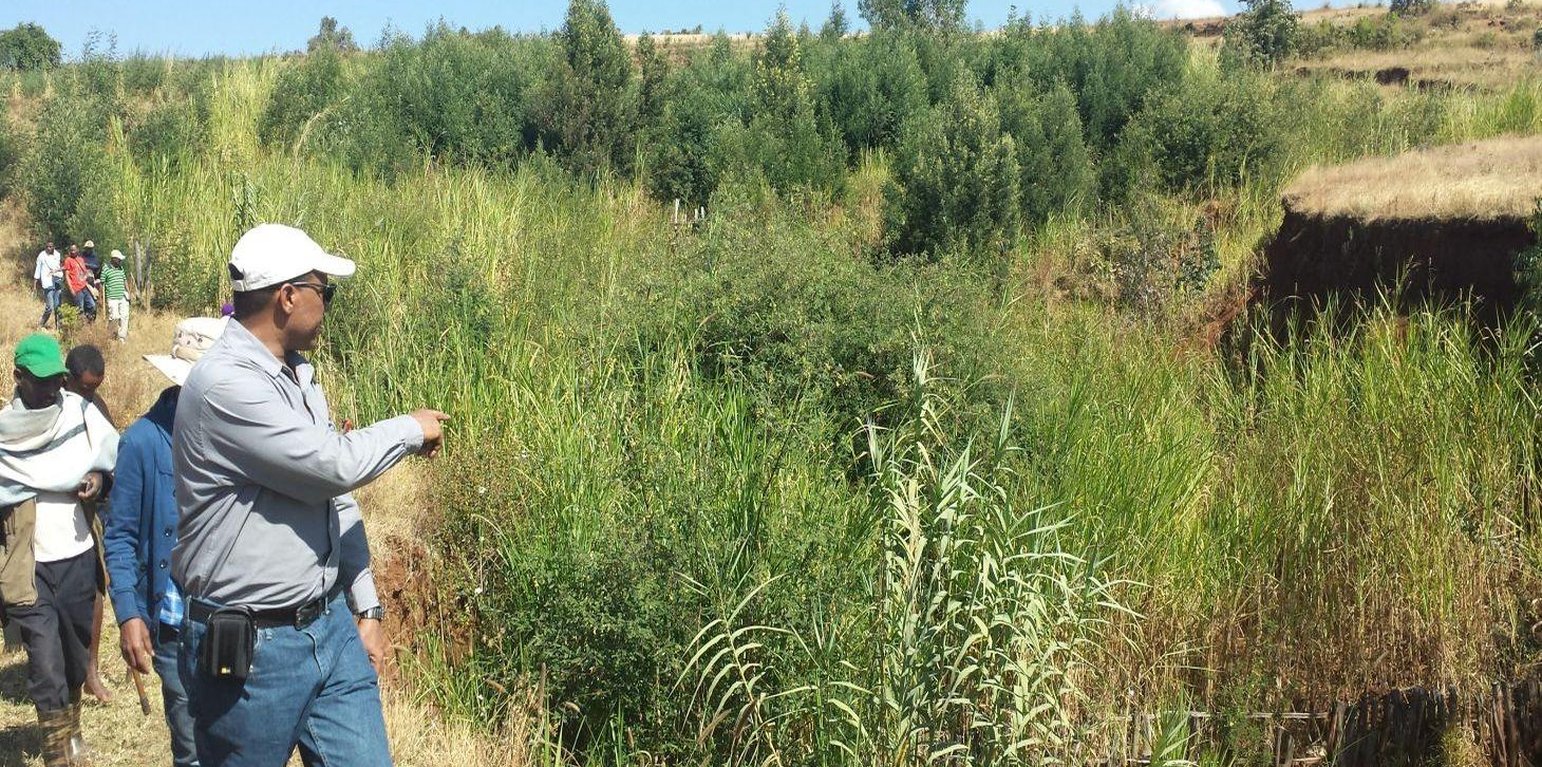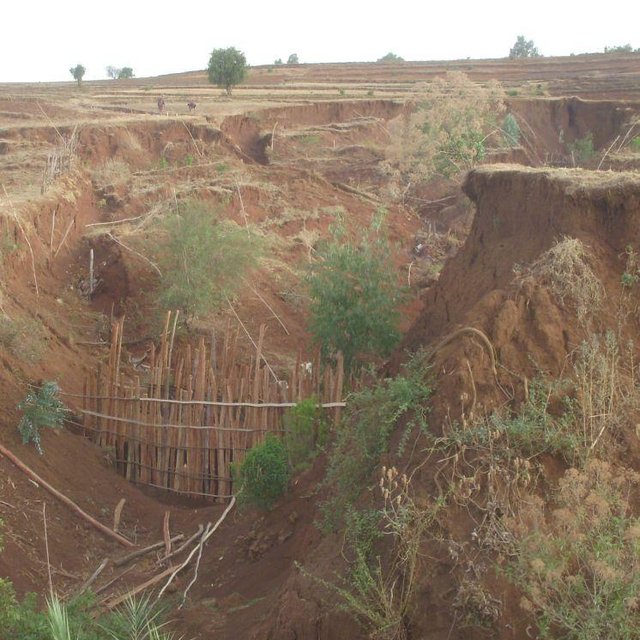



Gully erosion occurs on cultivated and grazing/pasture lands. Gully erosion management is a practice aimed to rehabilitate and protect further development of gullies and change into productive land. It involves both runoff management and erosion control activities. Gully management and treatment is different at upstream catchment area, gully head and gully section. Proper land management practices and slope treatment measures such as terraces, infiltration ditches and grass or shrub hedgerows are taking place on upstream catchment of the gully in order to reduce the rate of surface runoff. The excess runoff above the gully head is safely drained using cutoff drains into natural or properly vegetated waterways in order to reduce the surface water entering into the gully and protect the constructed physical and biological measures being washed away. Before treating gully sections, for the purpose of stability of structures and quick healing, the gully should be reshaped and planted with grass sod. Gully wall reshaping is cutting off steep slopes of active gully flanks in to gentle slope of minimum at 45% slope, up to two-third of the total depth of the gully and constructing small trenches along contours for re-vegetating slanted part of the gully walls and beds. If the gully is wide and has meandering nature with huge accumulation of runoff flowing down, it requires constructing of retaining walls, to protect displaced (not yet stabilized) soils and soil materials and the sidewalls of the reshaped gully. Stabilization of gully sections involves the use of structural and vegetative measures in the head, floor and side of the gully. The construction of physical structures inside the gully section is followed by establishment of biological measures.
Purposes of gully erosion management are: 1) rehabilitate the land damaged due to gully erosion, 2) prevent further expansion and development of gully erosion, and 3) convert the land lost by gully erosion to productive land.
Gully erosion management begins with assessment and mapping of gully erosion that helps to have an overview of erosion, to document extent of damage, to identify the nature and causes of gully formation, and gives relevant information to design appropriate measures. At establishment stage, gully management requires: catchment treatment using different land treatment measures; runoff diversion by cutoff drain; and stabilization of gully sections by physical structures and vegetative measures. Stones for the construction of terraces, cutoff drains and waterways are required. Depending on the nature of gully and available material for construction, either stones, sand bags, brush woods, bamboo mat, gabion or concrete (sand, gravel and cement) are needed for constructing check-dams in a gully section. Different tree/shrub seedlings, grass cuttings, and seedlings of fruit trees are required to reinforce and stabilize the gully sections. The respective labor requirement for stone collection, construction of retaining wall, and gully reshaping is 0.5m3/person day, 5m/person day, and 1m3/person day. Approximately 0.25, 0.50, 0.50, 0.50 , and 1.0 m3/person day is required to construct gabion, loose stone, arc weir, sand bag, and bamboo mat check-dams respectively. About 3.0 m/person day is needed to construct brushwood check dams. The treated gullies should be checked regularly. The maintenance requirement is closely monitored and immediate repair is essential to avoid further damage and eventual collapse of structures. The inputs important for maintenance include stones or other materials for check dams, seedlings to replant areas covered with non-survived seedlings.
Gully erosion is prevalent in areas where excess runoff occurs in high rainfall areas associated with moderate to high erodible soils. It occurs in range of wet highland to moist Kolla areas where annual rainfall exceeds 900mm. Its occurrence is more frequent in heavy clay soils (Vertisols) characterized by low infiltration and in clay soils (like Nitosols) characterized by low organic matter. Often, gully formation occurs on overgrazed pasture lands and inappropriately managed crop lands. Gully erosion control requires mobilization of high input or materials and labor. Larger gullies need to be rehabilitated and treated through community labor mobilization. Subsequent maintenance activities, monitoring and benefit sharing should be made by the user groups who are entitled to utilize the benefits.
The living condition depends on subsistence crop-livestock mixed farming. On average households have 5-6 family size. Crop production is meant for home consumption with small surplus for local market. The services related to water supply, energy supply, and infrastructure are low. Besides it is an asset, animals often used to cope shocks during drought periods.
Байршил: Dembecha/Mecha/Yilmana Densa, Amhara National Regional State (ANRS), Этиоп
Дүн шинжилгээнд хамрагдсан технологи нэвтрүүлсэн газрын тоо:
Технологийн тархалт: газар дээр жигд тархсан (approx. 10-100 км2)
Тусгай хамгаалалттай газар нутагт?:
Хэрэгжилтийн огноо: <10 жилийн өмнө (саяхны)
Нутагшууллын төрөл







| Зардлын нэр, төрөл | Хэмжих нэгж | Тоо хэмжээ | Нэгжийн үнэ (ETB) | Зардал бүрийн нийт өртөг (ETB) | Нийт дүнгээс газар ашиглагчийн төлсөн % |
| Хөдөлмөр эрхлэлт | |||||
| labour | ha | 1.0 | 8319.0 | 8319.0 | 99.0 |
| Тоног төхөөрөмж | |||||
| animal traction | ha | 1.0 | 9.0 | 9.0 | 100.0 |
| tools | ha | 1.0 | 901.8 | 901.8 | 50.0 |
| таримал материал | |||||
| grass | ha | 1.0 | 20.0 | 20.0 | |
| seeds | ha | 1.0 | 24.0 | 24.0 | |
| seedlings | ha | 1.0 | 63.45 | 63.45 | |
| Бордоо ба биоцид | |||||
| compost/manure | ha | 1.0 | 15.86 | 15.86 | |
| Барилгын материал | |||||
| stone | ha | 1.0 | 1405.0 | 1405.0 | 91.0 |
| wood | ha | 1.0 | 27.6 | 27.6 | |
| earth | ha | 1.0 | 91.2 | 91.2 | |
| Технологи бий болгох нийт үнэ өртөг | 10'876.91 | ||||
| Технологи бий болгох нийт үнэ өртөг, ам.доллар | 543.85 | ||||
| Зардлын нэр, төрөл | Хэмжих нэгж | Тоо хэмжээ | Нэгжийн үнэ (ETB) | Зардал бүрийн нийт өртөг (ETB) | Нийт дүнгээс газар ашиглагчийн төлсөн % |
| Хөдөлмөр эрхлэлт | |||||
| labour | ha | 1.0 | 902.0 | 902.0 | 67.0 |
| Тоног төхөөрөмж | |||||
| animal traction | ha | 1.0 | 4.5 | 4.5 | |
| таримал материал | |||||
| grass | ha | 1.0 | 10.3 | 10.3 | |
| seedlings | ha | 1.0 | 33.0 | 33.0 | |
| Бордоо ба биоцид | |||||
| compost/manure | ha | 1.0 | 8.5 | 8.5 | |
| Барилгын материал | |||||
| stone | ha | 1.0 | 50.0 | 50.0 | 41.0 |
| wood | ha | 1.0 | 14.4 | 14.4 | |
| earth | ha | 1.0 | 45.6 | 45.6 | |
| Технологийн арчилгаа/урсгал үйл ажиллагаанд шаардагдах нийт үнэ өртөг | 1'068.3 | ||||
| Технологи арчилах ба урсгал ажлын нийт үнэ өртөг, ам.доллар | 53.41 | ||||
Gullies are treated for purpose of improved grass and legume fodder production like napier, susbania, local grasses
Honey, fruits can be diversified under intensive gully development
High fodder biomass provide an opportunity to do fattening; sometimes used to grow fruits;
Under low productive soil where recovery rate is slow, establishment and maintenance cost of labor is high
Watershed committee and user groups are established
Awareness of the community on gully management increased
Gullies are stabilized and no more conflict
Land users are organized into user groups and harvest the biomass (grass and fodder) for livestock feed which result in increased livestock productivity. Some land users attempt to fatten cattle and gain benefit.
Significant reduction of damage due to runoff
Cutoff drains used to drain excess runoff upstream
Plantation of gullies increase cover and biomass production
Check dams significantly reduce the soil loss from gullies
Stream size and duration has improved
Reduction of damage on houses